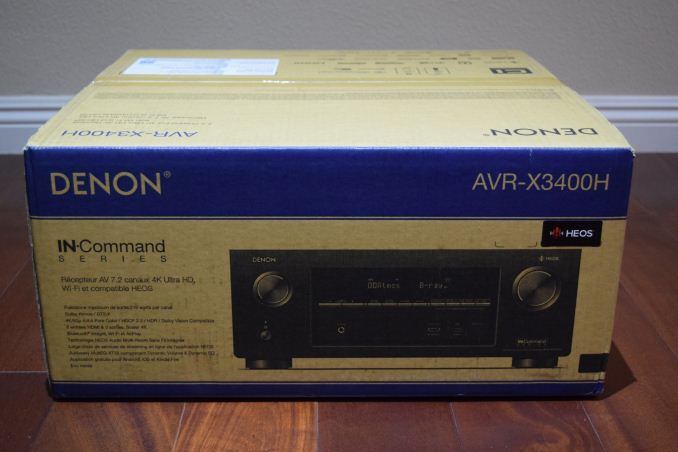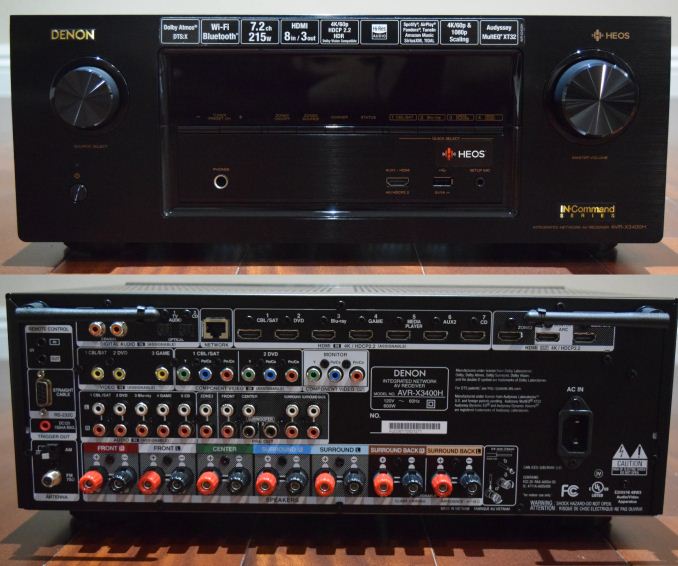A Budget Home Theater & PC Setup: 4K, HDR, UHD Blu-ray, and More
by Ganesh T S on December 26, 2017 8:30 AM ESTThe AVR: Denon X3400H
The choice of AVRs used to be a difficult one to make when support for different HD audio formats was not widespread. Now, the requirements boil down to the AVR being able to support the latest HD audio formats (Dolby Atmos and DTS-X), while matching the capabilities of the display in the chain. The additional features may help sway the purchase decision for consumers.
Budget considerations dictate the number of channels and display zones. We had to migrate from the 7.1 channel Pioneer Elite VSX-32 to a newer receiver capable of handling multiple HDMI 2.0 / HDCP 2.2 inputs with passthrough capabilities for various HDR formats. Based on my budget, I narrowed down the options to one of the models from Denon, Onkyo, Pioneer, and Yamaha. They are all in the same ball park in terms of pricing for a given feature set. We deferred to our friends at Wirecutter, who recommended the Denon AVR S730H.
I had been in touch with Denon regarding HEOS (their whole home audio solution) when the decision to go with a Denon AVR for our HTPC testing setup was taken. Upon discussing our project with them, Denon graciously agreed to sponsor the more advanced AVR X3400H for use in our testing.
The AVR X3400H targets the custom integrator channel. It has a number of additional features such as support for high end DSD audio, 4Kp60 upconversion for analog sources, multi-zone video outputs, higher power output, and support for eARC (Enhanced Audio Return Channel) to justify its higher price over the S730H. The presence of eARC makes it a bit more future-proof, as it allows for HD audio (including the new ones like Dolby Atmos and DTS-X) from the display sink to be returned to the AVR for decode and playback.
In the course of our testing, we found that the AVR received frequent firmware updates to add new features such as HLG passthrough. These point to a well-supported product. Even though the web control feature present in the previous generation Denon AVRs was missed, the Denon AVR Android app made up for it to some extent. None of the issues encountered in the course of the evaluation presented in this piece could be attributed to the Denon AVR X3400H.
If we had to give some suggestions to Denon for the improvement of the AVR X3400H, it would be to bring back the web control feature and shorten the time taken for firmware updates (though there is a facility to enable auto-updates that tries to install the new firmware when the AVR is not being used).
Speakers
Most readers upgrading their HTPC can opt to retain their existing speakers. In fact, I had the Boston Acoustics Horizon Series MCS100MDNT 5.1-channel speaker system from a 2008 purchase, along with a Jamo A306 HCS 5.1 speaker system from my 2011 home theater components upgrade. However, due to the remodel, I had to go in for in-ceiling speakers. I opted for a couple of the Polk Audio RC80i in-ceiling pairs for the rear and surround channel speakers. I bundled them along with ceiling speaker protective covers. The choice of speakers depends on the home theater size and other requirements. Currently, I am using the Jamo A306 speakers for the front, center, and subwoofer, with the Polk Audio RC80i for the other channels.












191 Comments
View All Comments
mikato - Thursday, January 18, 2018 - link
Great point, and I also agree... unless you want local storage for media content. Sure I guess the response would be to have a PC (when we had been leaving out the PC) or a NAS feed content with DLNA or whatever that is with Plex or Kodi over the network. But then you have quite a bit more than just whatever box or stick. And if you wanted to bring your content with you to a friend’s house, you couldn’t do that, when you might be able to pretty easily with one of the UCFF PCs with a disk in it. Plus I’ll add that would be able to play anything, when for instance you might not be able to play YouTube with your Amazon stick or play Amazon with your Google stick.We’re close, but not quite there yet. What is there does cover things enough for a lot of people though.
Duto - Friday, December 29, 2017 - link
A TCL TV set?, really? , unbelievable!rapster - Friday, December 29, 2017 - link
Thank you for your thoughtful review of some of the tricks, traps, and solutions of the 4K HDR space. As someone who recently had to deal with a few of the challenges you worked through I really appreciate it. Your recommendation of the NVIDIA Shield is especially well-considered and would have saved me a lot of time for my applications. The comments section here has some gold to be mined as well.As for budget: I paid twice as much for my receiver as the $999 one you recommended and still consider it to be a budget unit. Anybody who has been to a "real" media equipment store understands this. Sorry to be "that guy" on my first post here, but I might suggest it's time for some folks (cough ddriver) to leave mom's basement and that job at the mall and get out more.
ronraxxx - Friday, December 29, 2017 - link
THANK YOU - I was getting so triggered reading these comments. "Budget" is relative. A brand new Kia costs $10,000 - it's still a *budget* vehicle in the world of new cars. Real home theater equipment is expensive - the key word being "THEATER." If you want a true, immersive, theater-like experience it usually is very expensive. If you only have $1000 to spend on your home "theater" I hate to break it to you but the TV, soundbar, and Roku that fits your budget isn't really a theater at all, unless you're in a dorm room.Reflex - Friday, December 29, 2017 - link
This right here. People get hung up on the word Budget. If the author could do one thing differently IMO it would be to define what the actual price tiers he is using are. People could yell all they wanted about how a $500-2000 range for budget receives isn't 'budget' in their world, but at least they'd know the author's definition.Honestly the compromise he made in this that I wouldn't have is the TV. Nothing against TCL, but seriously if you are building a theater it seems like what you look at should be the number one priority. I spent about $3k in total on my setup (budget!) and $2k of that was the tv. There is also the consideration of space, in my case the space permitted isn't theater quality or size, so the 'budget' consideration is different as spending $10k on speakers would gain me nothing in the space allowed.
I'd like to see Anandtech cover this space. I like the practical approach they took here and the mostly plain language. I like how the final reccomendation list had options on most of the items so people could easily define their priorities. But if they do go forward they should define some basic terms like what is considered 'budget' for both individual components and for a total setup, and what kind of spaces they are trying to address (dedicated theater? living room? corner of a bedroom?). With that in place most of the arguments in this thread become pedantic noise.
Bullwinkle-J-Moose - Saturday, December 30, 2017 - link
" The comments section here has some gold to be mined as well."---------------------------------------------------------------------------------------
Well thank you for those kind words Rapster, and remember kids......
If you can't sing, you can always Rap!
FreckledTrout - Sunday, December 31, 2017 - link
I agree completely. I have about 2.5K into my home theater sound(not including anything not sound related) and I felt that was rather budget oriented. I did put about $700 into a SVS subwoofer which in my opinion is what makes or breaks most home theater builds.Lau_Tech - Friday, December 29, 2017 - link
Assuming the point of the article was to promote the receiver... Why not just focus on reviewing the receiver? Many sites have also compared htpc with Xbox and ps4s.. An article on that would have been useful as well.As it stands the article simply feels amateurish and unfocused. What article on setting up a home theater (budget or otherwise) focuses on the receiver and htpc at the cost of the cornerstone elements:TV and speakers?
I truly do not know why efforts were expended in this new, odd direction when other product reviews are in higher demand.
HStewart - Friday, December 29, 2017 - link
One thing I curious about is GPU support for UHD. It appears you need Intel 630 or higher in Kaby Lake or the Xbox. Note even thought Xbox has older generation CPU and GPU, Microsoft must have modified the GPU to support UHD 4k. My guess is both NVidia and AMD will follow suit next year.One things that this defunct is claims that Kaby Lake is no different than previous generations Intel processors. And unfortunately for me having older i7, it can't be claimed that Intel is just doing this for people to buy new cpus - since both NVidia and AMD don't support it.
The Jedi - Saturday, December 30, 2017 - link
Thanks Ganesh, good article. With a 4K Android TV and an Ultra HD Blu-Ray player, the HTPC's days are past. Me personally, I will keep my Windows Media Center HTPC for the DVR functionality, indefinitely.The standalone UHD Blu-Ray player is simpler, cheaper, and no-nonsense.
Android TV is something for services to rally around. Even with the security platform provided by Kaby Lake/Coffee Lake and Windows 10, services besides Netflix are not rushing to bring 4K to the PC.
A year ago I was so psyched about upgrading to a Kaby Lake i7 to be on the latest system and get onboard and support the PC 4K ecosystem. What impressed me was that Intel was working on overcoming the challenges that kept 4K discs and 4K services away from the PC. But, I decided I didn't really need it or Coffee Lake, and it was cheaper to keep my investment in DDR3. I upgraded to a Haswell Refresh instead.